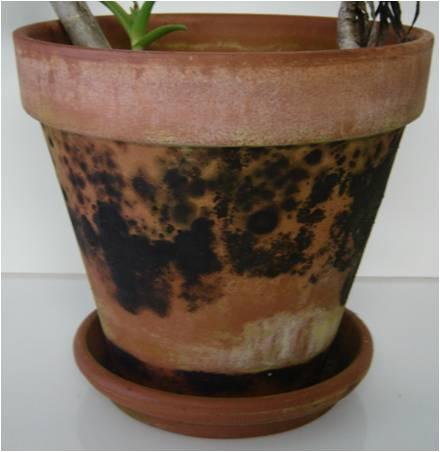Most likely, we all have them-garden pots. These typically are made of plastic, clay or wood. Garden pots should be sanitized if they were previously used or if they exhibit signs of mold or fungal growth. Whether they are used as garden boxes, planters, or hanging baskets, the surfaces of garden pots can harbor disease organisms, along with unsightly stains and mineral salts deposits. Salts from hard water and fertilizers can leach though clay pots leaving a white film on the pot’s outer surface. Salts accumulation can become flaky and encrusted around the rim and drainage holes of plastic and clay containers.

Mold or fungal growth on an unglazed terra-cotta (clay) pot Photo Credits: Alex Bolques, FAMU Research
To clean clay or plastic containers, use a brush or fine steel wool to remove dirt and debris and wash with a liquid soap detergent. If stains persist, consider using a 50:50 solution of water and vinegar. To sterilize clay or plastic pots, soak them in a mild solution of bleach, 1:10 bleach to water, for about 30 minutes. Then, immerse them in clean water and allow them to dry completely. Containers made of wood are different. If the timber that they are made of is not treated properly, they tend to rot and can harbor disease spores or bacteria. It is best to replace these as they show signs of wear or deterioration. Sanitizing your garden pots will help you avoid unwanted disease problems and unsightly garden container pots.
- Recycle By Cleaning Your Container Pots - July 28, 2015
- A Fluffy Woolly Mass on Woody Plants - June 17, 2014
- Preventing Heat Stress: Plant and People Considerations - May 13, 2014
